Types of Google ADS campaigns: What to choose for your business?
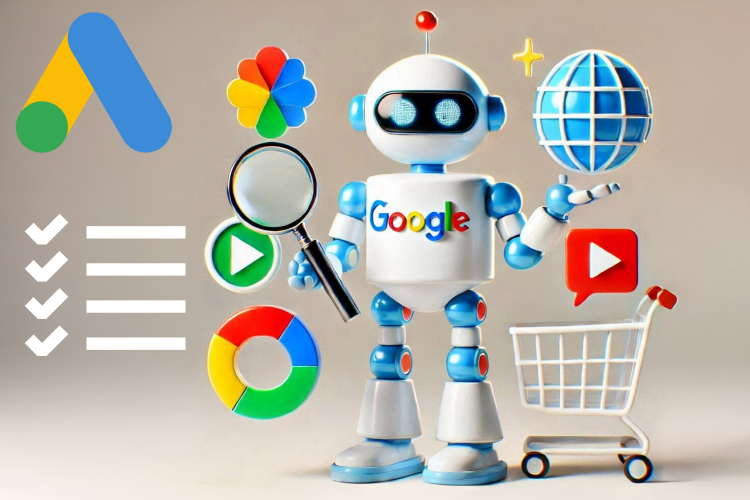
- Overview of different types of Google Ads campaigns
1.1. Search campaigns
1.2. Display campaigns
1.3. Video campaigns
1.4. Shopping campaigns
1.5. App campaigns - Recommendations for choosing a campaign type for your goals
2.1. How to determine your campaign goal
2.2. Choosing the right campaign type for conversions, branding, or engagement - Examples of successful use cases for different campaign types
3.1. Search campaigns: Local services
3.2. Display campaigns: Branding for e-commerce
3.3. Video campaigns: YouTube engagement
3.4. Shopping campaigns: Online stores
3.5. App campaigns: Increasing downloads
1. Overview of different types of Google Ads campaigns
Google Ads offers several different campaign types that you can use depending on your business needs. Each type has its own unique features and capabilities, so it’s important to understand how and when to use them.
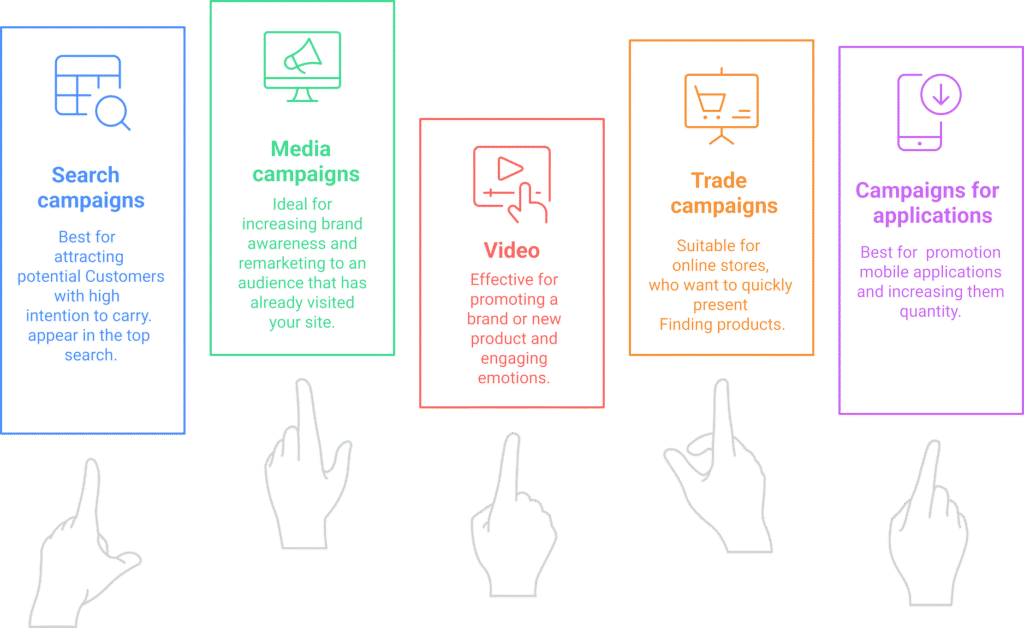
1.1. Search campaigns
What it is:
Search campaigns focus on showing text ads within Google search results. They’re the perfect choice if you want to catch customers when they’re actively searching for your product or service.
When to use:
- To attract potential customers with high purchase intent.
- For local businesses that want to appear at the top of search results.
“Search campaigns are a tool that allows you to appear in front of the client at the right moment. If someone searches for “apartment renovation in Kyiv” and your ad is the first in the results, the chances of conversion are very high.”
Example:
An apartment renovation company launched a search campaign with the keywords “renovation in Kyiv”, “turnkey renovation” and “renovation prices”. The result was a 40% increase in applications within the first month.
1.2. Media campaigns
What it is:
Display campaigns allow you to show image ads on websites, apps, and Gmail based on interests, behavior, or context (page content).
When to use:
- To increase brand awareness.
- For remarketing to an audience that has already visited the site.
“Display advertising is an opportunity to leave a mark in the mind of a customer. Even if they don’t click right away, your ad can bring them back later.”
Example:
An online store launched a display campaign with remarketing for visitors who abandoned their cart. Creative banners with “Complete purchase – get a discount” returned 15% of users.
1.3. Video campaigns
What it is:
Video campaigns allow you to promote your business using videos on YouTube and partner platforms.
When to use:
- To promote a brand or a new product.
- To engage emotions and create a response.
“Video can convey more in a few seconds. It captures attention, conveys emotions, and increases brand awareness.”
Example:
A small business producing eco-friendly tableware created a 30-second video explaining the benefits of their product. The YouTube campaign reached 500,000 views in 2 weeks and saw a 20% increase in sales.
1.4. Shopping campaigns
What it is:
Shopping campaigns show product ads directly in Google search results with a photo, price, and description.
When to use:
- For online stores.
- For quick product presentation in search.
Example:
A clothing store added its product range to Google Merchant Center. Shopping campaigns drove 10,000 new visitors to the site in a month.
1.5. App campaigns
What it is:
These campaigns help promote mobile apps, increasing their downloads and user engagement.
Example:
A food delivery service launched an app campaign targeting users searching for “food delivery.” Downloads increased by 50%.
2. Recommendations for choosing a campaign type for your goals
An effective Google Ads campaign starts with setting goals. Without a clear goal, you risk spending your budget without getting the results you want. Let’s look at how to set a goal correctly and choose the right campaign type to achieve specific business goals.
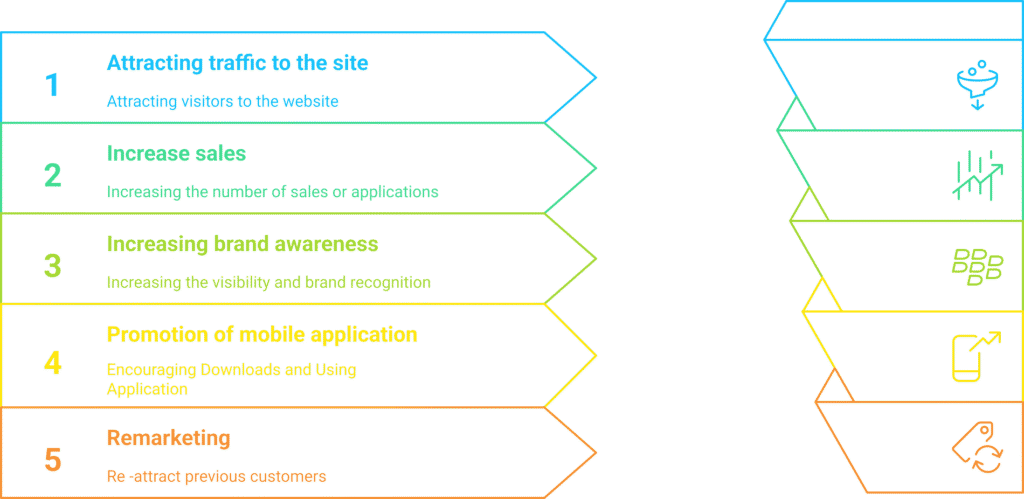
2.1. How to determine the goal of a campaign
Before you launch an ad, you need to understand what exactly you want to achieve: increase sales, increase awareness, or attract a new audience? Your goals should be SMART – specific, measurable, achievable, relevant, and time-bound.
Main types of goals:
- Driving traffic to your site.
If your site is new or you are starting a blog, your main goal is to drive as many visitors as possible. The emphasis here is on the number of clicks, not conversions. - Increase sales or signups.
If your business is focused on online sales, services, or lead generation, conversions—specific actions that generate revenue, such as purchases, signups, or subscriptions—are a priority. - Increase brand awareness.
When your business is just starting out or you’re launching a new product, you want as many people as possible to know about you. In this case, advertising should focus on reach and frequency of impressions. - Mobile app promotion.
If you have an app, the main goal is to increase the number of its downloads or active users. - Remarketing.
When you need to “return” users who have already interacted with your brand but did not complete a purchase or other action.
“Clearly defining the campaign goal helps you focus on key performance indicators. Without the right goal, it is impossible to measure the success of an advertising strategy.”
Example:
An online store has determined that it wants to increase sales by 20% in 3 months. The goal is specific and measurable: in this case, launching search and shopping campaigns would be the most effective.
2.2. Choosing the right campaign type for conversions, branding, or engagement
Understanding your goal will help you choose the right campaign type that best suits your goals. Let’s look at detailed recommendations for each category:
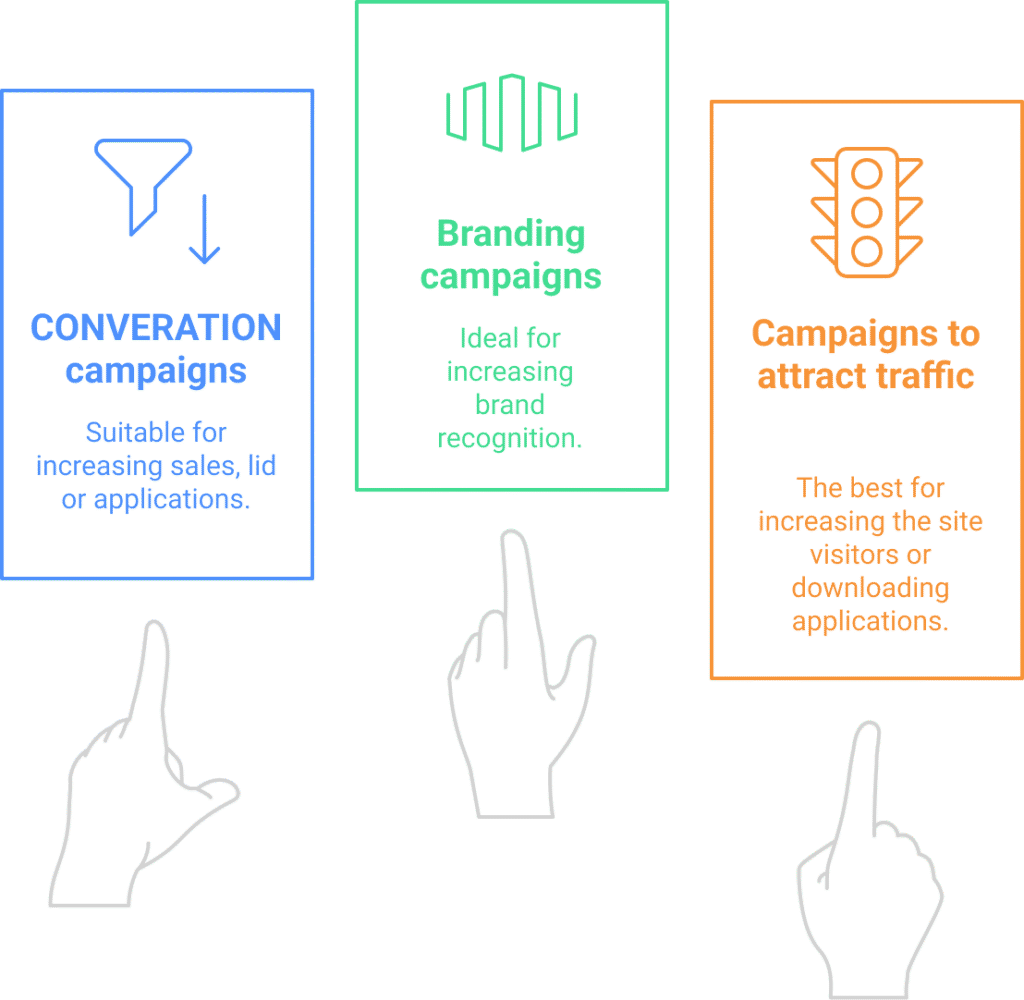
A. Campaigns for conversions (sales, leads, applications)
Suitable for: Search campaigns, shopping campaigns, and remarketing.
- Search campaigns are the best choice for businesses that want to “catch” a user while they are actively searching for a product or service. They work based on keywords with high conversion intent.
- Example: “Buy an Acer laptop”, “renovate an apartment in Lviv”.
- Shopping campaigns are ideal for e-commerce, where it is important to showcase the product with price and photo right in the search results.
- Example: An electronics store saw a 30% increase in sales thanks to shopping campaigns for specific product categories.
- Remarketing in display campaigns allows you to bring back customers who viewed your site but did not complete a purchase.
- Example: The banner “Return and complete your purchase with a 10% discount” returned 20% of customers.
“For conversion-focused campaigns, ad relevance and keyword targeting are key to success.”
B. Branding campaigns (increasing awareness)
Suitable for: Display campaigns and video campaigns.
- Display campaigns allow you to reach a wide audience with graphic banners on various websites. This is an ideal choice for increasing brand awareness.
- Tip: Use attractive banners with short and clear messages.
- Video campaigns on YouTube will help create an emotional connection with your audience and tell your brand’s story.
- Example: A new cosmetics brand launched a 30-second video on YouTube that received 1 million views and increased brand awareness by 25%.
“Branding is important for the long-term success of a business. When customers are aware of your brand, their loyalty increases.”
C. Campaigns to drive traffic (website visitors, app downloads)
Suitable for: Display campaigns, app campaigns, and search campaigns with broad keywords.
- Display campaigns will help bring new users to the site by targeting interests or behavior.
- Tip: Use attractive CTAs (calls to action) on banners.
- App campaigns focus on promoting mobile apps on Google Play and the App Store.
- Example: A taxi service received 50,000 new downloads thanks to a campaign focusing on promotional offers for new users.
- Broad keyword search campaigns attract traffic from people who are undecided but interested in your niche.
“For engagement campaigns, it’s important that your site or app is optimized for the user. Otherwise, you risk losing potential traffic.”
Choosing the right campaign type depends on your goals. Search and Shopping campaigns focus on conversions, display and video campaigns focus on awareness, and app campaigns focus on acquiring new users. Carefully analyze your business objectives and customize your campaigns to best meet your goals.
3. Examples of successful cases of using different types of campaigns
One of the best ways to understand the effectiveness of Google Ads is through real-world case studies that demonstrate successful results for businesses of all sizes and industries. Each campaign type has its own advantages and can be optimized for specific business goals: conversions, branding, or attracting new audiences. Let’s take a look at three detailed examples that will clearly show you how to properly set up your ads and achieve the desired results.
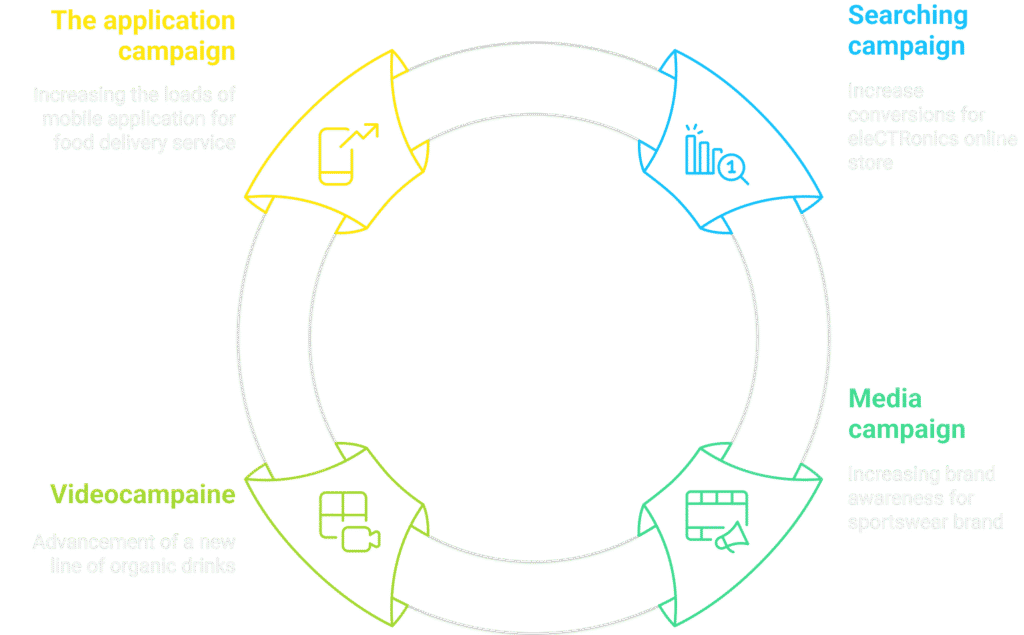
3.1. Search campaign to increase conversions
Case: Online electronics store
Task: An online retailer wanted to increase sales of laptops and tablets in the run-up to the holidays. The goal of the campaign was to achieve maximum conversion rates within a limited budget.
Decision:
- Selecting relevant keywords: Marketers created separate campaigns for each product category: “laptops,” “tablets,” and “accessories.” Exact and phrase match were used for the highest-converting keywords.
- Ad optimization: Ad texts included keywords, limited-time promotions (“20% off laptops until the end of the week”), and a clear call to action.
- Extensions: Added extensions with prices, links to category pages, and reviews.
Results:
During the campaign period (2 weeks):
- Conversions increased by 35% .
- Cost per conversion decreased by 20% thanks to fine-tuning of keywords.
- Advertising revenue exceeded costs 5 times (ROAS = 500%) .
“Search campaigns work best for hot customers who are ready to make a purchase. The key is to set up the keywords correctly and make the ads as attractive as possible.”
3.2. Media campaign to increase brand awareness
Case: Sportswear brand
Task: A new sportswear brand wanted to make a name for itself on the market and increase its recognition among a young audience aged 18-35.
Decision:
- Targeting Choice: The brand set up a display campaign targeting an audience interested in sports, fitness, and fashion. Geographically, the campaign was limited to large cities.
- Creatives: Bright banners were created with an emphasis on product quality, stylish design, and a sporty lifestyle. The visuals were key to attracting attention.
- Frequency of displays: The optimal frequency of banner display was chosen – no more than 3 times per user per week to avoid ad fatigue.
Results:
In 1 month of the campaign:
- The brand has reached a reach of over 1 million users .
- Recognition among the target audience increased by 40% (according to the survey).
- Traffic to the site increased by 70% , and the first sales brought a positive ROI .
“Media campaigns are ideal for increasing brand awareness. It is important to create high-quality and relevant creatives that are memorable to the target audience.”
3.3. Video campaign to promote a new product
Case: Organic beverage company
Objective: To promote a new line of organic drinks and emphasize their advantages – natural composition and health benefits. The main goal is to attract attention and generate interest in the brand.
Decision:
- YouTube video campaign: The company created a series of 15-second video ads that showed the product in action: athletes drinking the drinks after workouts and families using them as a healthy alternative to sugary drinks.
- Targeting: The campaign was set up for YouTube users who are interested in a healthy lifestyle, fitness, and cooking.
- CTA in the video: A clear call to action to go to the website to receive “10% off your first order.”
Results:
In 3 weeks of the campaign:
- The video received 500 thousand views with a high engagement rate.
- Traffic to the site increased by 60% .
- Sales of the new line of drinks increased by 25% compared to the previous period.
“Video campaigns are great for showcasing the benefits of a new product. YouTube offers the opportunity to maximize engagement through short and emotional videos.”
3.4. App campaign – mobile app promotion
Case: Food delivery service
Objective: Increase the number of mobile app downloads and active users in the new region.
Decision:
- Automated App Campaign: Google Ads allows you to automatically set up an ad-based app promotion campaign, optimizing impressions for maximum downloads.
- Creatives: We used banners, videos, and ads that showcased the convenience of ordering food with just one click.
- Promotion for new users: “50% discount on your first order through the app.”
Results:
- The app received 20,000 new downloads in its first month.
- The number of active users increased by 15% .
- The conversion rate from installations to first orders was 30% .
“App campaigns optimize your ads for maximum downloads, which is especially useful for quickly scaling new markets.”
Conclusion:
Each type of Google Ads campaign can be a powerful tool for achieving different goals: from sales and leads to increasing awareness or attracting new users. Real-world cases show that the key to success lies in the right setup, high-quality creatives, and a clear understanding of business goals.



